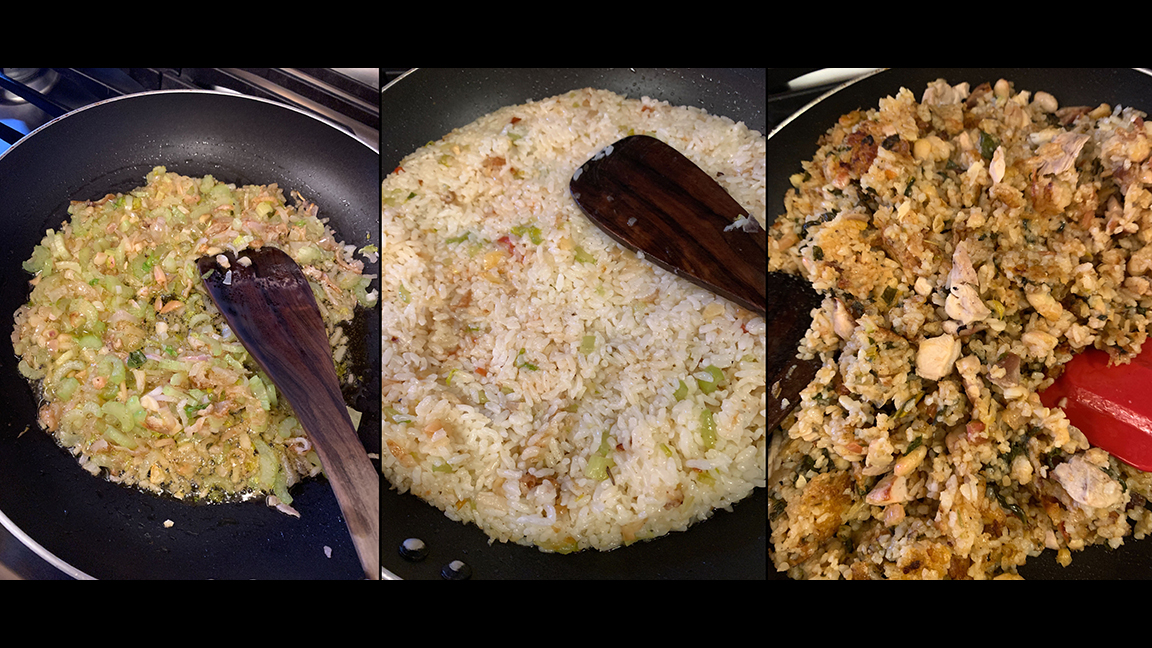
IT STARTED OFF as a private indulgence, which also helped tidy up the refrigerator, but under the pandemic there are no private indulgences anymore. When I owed lunch to no one but myself, and when there was a little bit of leftover cooked meat with its jellied-up pan juices in the fridge, I would do this: scrape the fat from the top of the juices into a little frying pan, cover it with a layer of leftover rice, get it heated up, and pour the juices over it. When the liquid cooked down and the rice started getting crispy on the bottom, I’d put the leftover meat on top, sliced up, to warm it through.
Over the past 12 months, with everyone needing lunch every day, it gradually developed into something more. I switched to a large pan, and started adding more things, but the basic rhythm of it was the same. One day, when I put it on the table, the younger child, who was then eight years old, referred to it “clobbed-together rice,” as if that were already understood to be its name. He does this fairly often, matter-of-factly: if adults can use a word he’s never heard before, and count on him picking it up, then when he needs a word he can just do the same. Immediately, therefore, that was the name of the dish.
(I may or may not have been caught, as some subsequent lunchtime approached, singing “Clob together / Rice now” over the stove.)
All there is to it is this:
Put the fat from leftover meat into a 12-inch nonstick pan and melt it over low heat. Add some olive oil if the fat doesn’t generously cover the bottom of the pan. Chop up one shallot or a small onion or something similar. Chop up a stalk or two of celery, with leaves. If you have some shishito peppers you haven’t gotten around to cooking, or some that you did cook and didn’t finish eating, chop up one or two of them. Dump the chopped vegetables into the pan, salt them, and cook on medium or medium-low heat for five minutes or so, stirring occasionally, until they’re softening and sizzling.
Scoop cold leftover rice over the oil and vegetables and flatten it out with your stirring implement until it makes an inch-thick layer filling the bottom of the pan. Stir it around a little to distribute the oil and warm it all up.
Scoop or pour the leftover pan juices over the rice. Stir them into the rice as they liquefy. Let it all start cooking down.
If meat was something slow-cooked in the first place, like lamb shank or pork shoulder, it can go in the pan at this point. If it’s from a pork chop or something that shouldn’t be overdone, cut it into bite-sized pieces and save it till the end.
Add something else, if you want. Fresh green peas are good. If there aren’t any peas, a can of beans is good in a different way. Some leftover cooked greens—chard, collards, that sort of thing—might make sense. Anything else you want to get rid of that doesn’t clash with what’s in the pan.
Mix the new additions in gently and let it all sit and cook. You can add some more spices to whatever the meat cooked with in the first place, depending on what seems like it would harmonize: cayenne? Paprika? Cumin? Whatever makes sense and doesn’t take too much effort.
Dig up part of the rice from the bottom now and again to see if it’s getting brown and crispy. If it is, turn it over and let some of the other rice take a turn at the bottom. Keep this up until your hunger or boredom grows stronger than your desire for brown and crispy rice. Then you’re done: clobbed-together rice.
